In Japan, prior to the 1860s, there was little distinction made between ‘fine’ and ‘decorative’ arts. All creative works, from ceramics to silk painting, could reflect high culture and enjoy an elevated status. The visual arts in Japan flourished in isolation for centuries, due to the nation’s strict closure to foreign influence. This changed as the country began to adopt Western cultural norms upon opening up to the West in the 1860s. As a result of this significant political and cultural shift, traditional art forms deemed to be crafts’” – ‘kougei’ – were relegated to a secondary status beneath the fine arts – ‘bijutsu.’ This somewhat artificial categorization has faced numerous challenges over the years, and though it is still evident today, its lines have become blurred again.
An increasing number of Japanese creators who began as artisans have found themselves celebrated as contemporary artists. Craft techniques and materials associated with traditional Japanese culture are always close at hand and carry a cultural resonance frequently suited to the aims of contemporary practice.
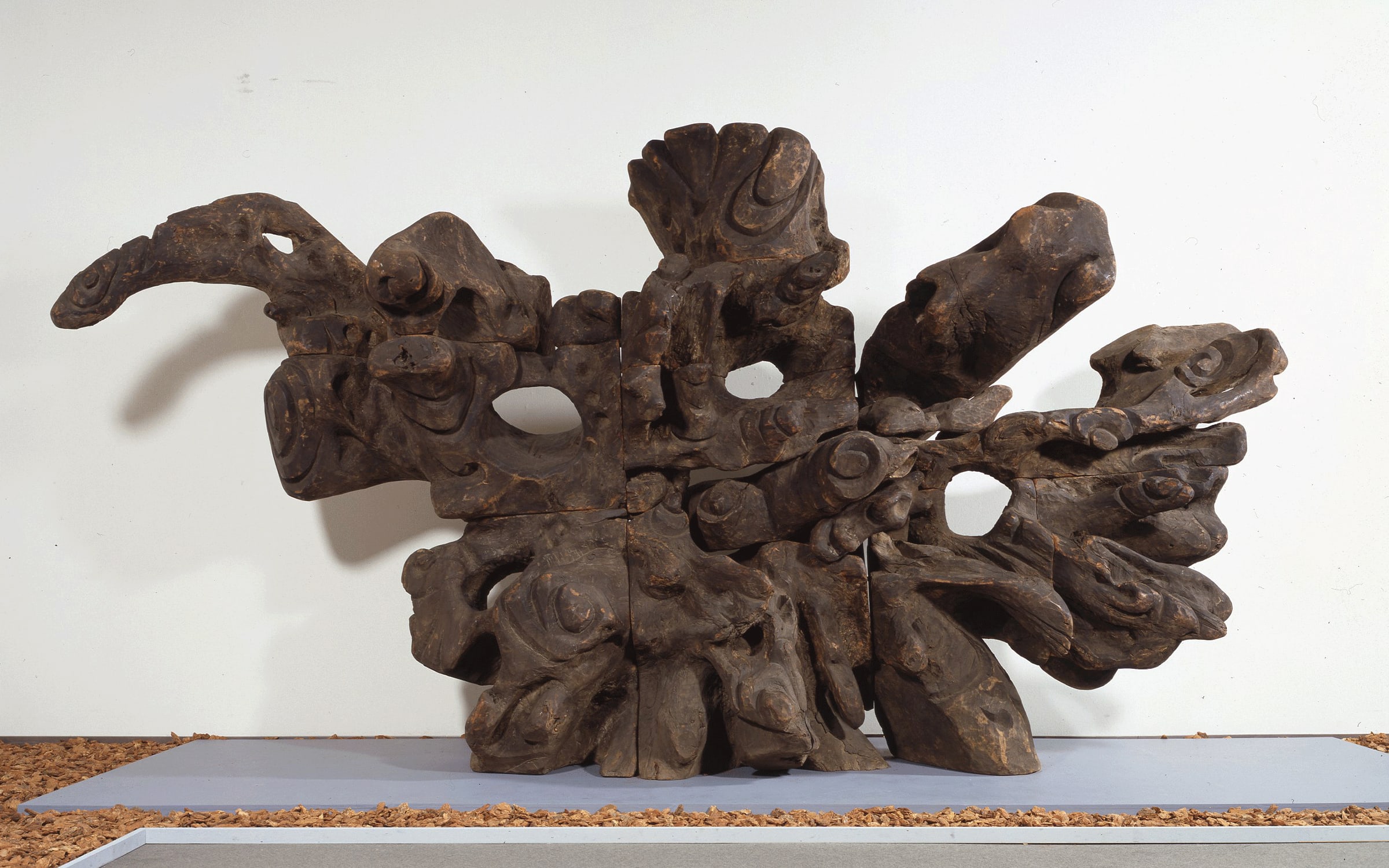
The late Sōfū Teshigahara (1900–1979) was a central figure in Japan’s Postwar art world, and his work encapsulates much of the energy and tension between traditional and contemporary Japanese art forms. Teshigahara was trained by his father in traditional ikebana, a centuries-old form of flower arranging which emphasizes restraint, simplicity, and adherence to rules. In 1927, Teshigahara broke with precedents and began his own ikebana school, called Sogetsu, meaning ‘grass moon’, which was devoted to exploring the possibilities of more creative and imaginative floral arrangements. His prolific late output included energetic sculptural works, calligraphy, and painting, combined with dynamic, ephemeral large-scale floral arrangements.
A number of Teshigahara’s major works, like Iwato
(1962) and Yakumo (1962), meaning ‘eight clouds’, are markedly frontal and clearly intended to be viewed from only one side – like traditional ikebana. The artist considered his sculptures to be ‘arrangements’ and produced them in parallel to his adventurous ikebana work. A number of his early sculptural works showcase his characteristic technique of using thin brass or lead plates hammered into place over roughly-carved and connected abstract wooden forms. In other works, thicker bronze plates were beaten into shape over the carved wooden forms, removed, and welded together.
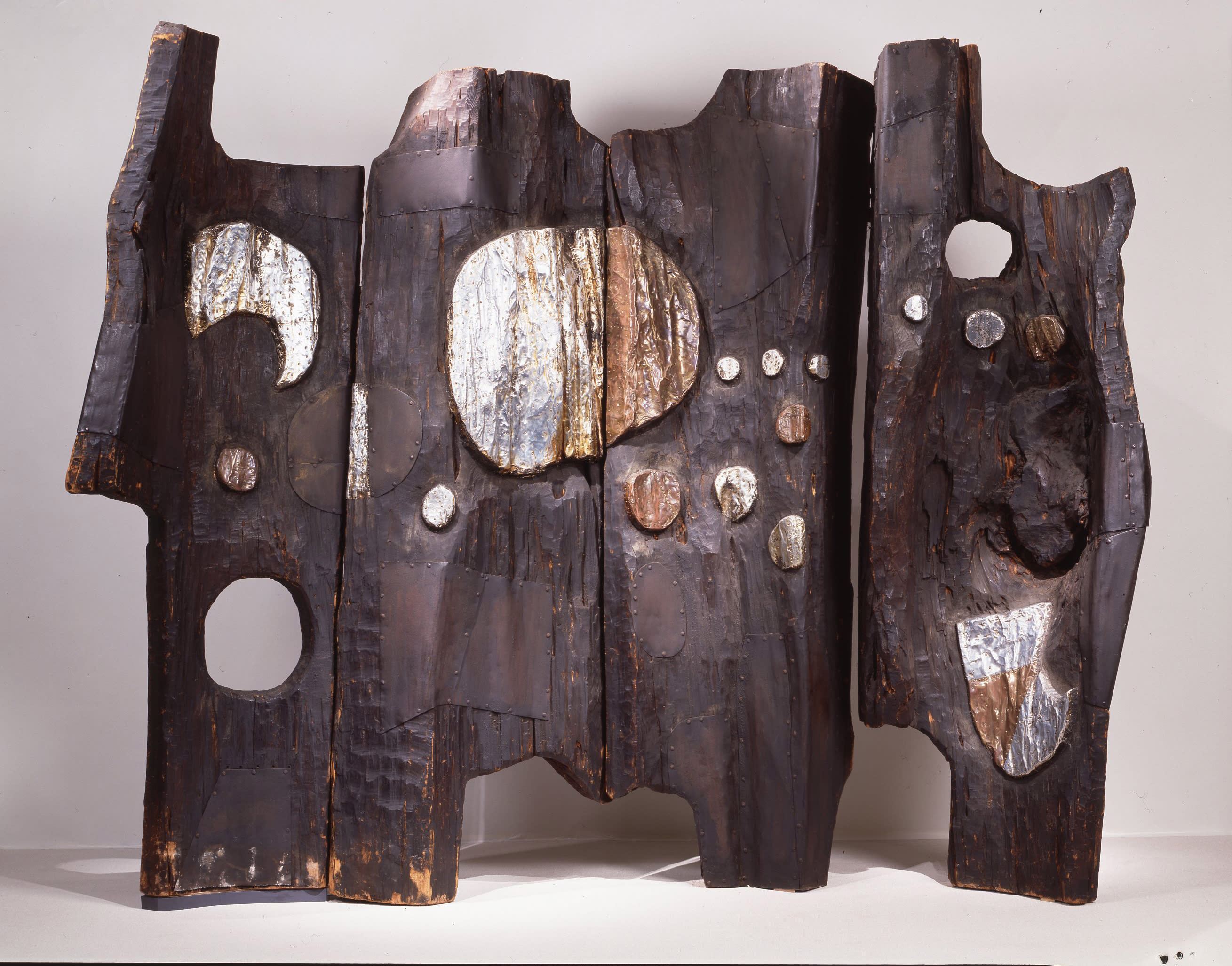
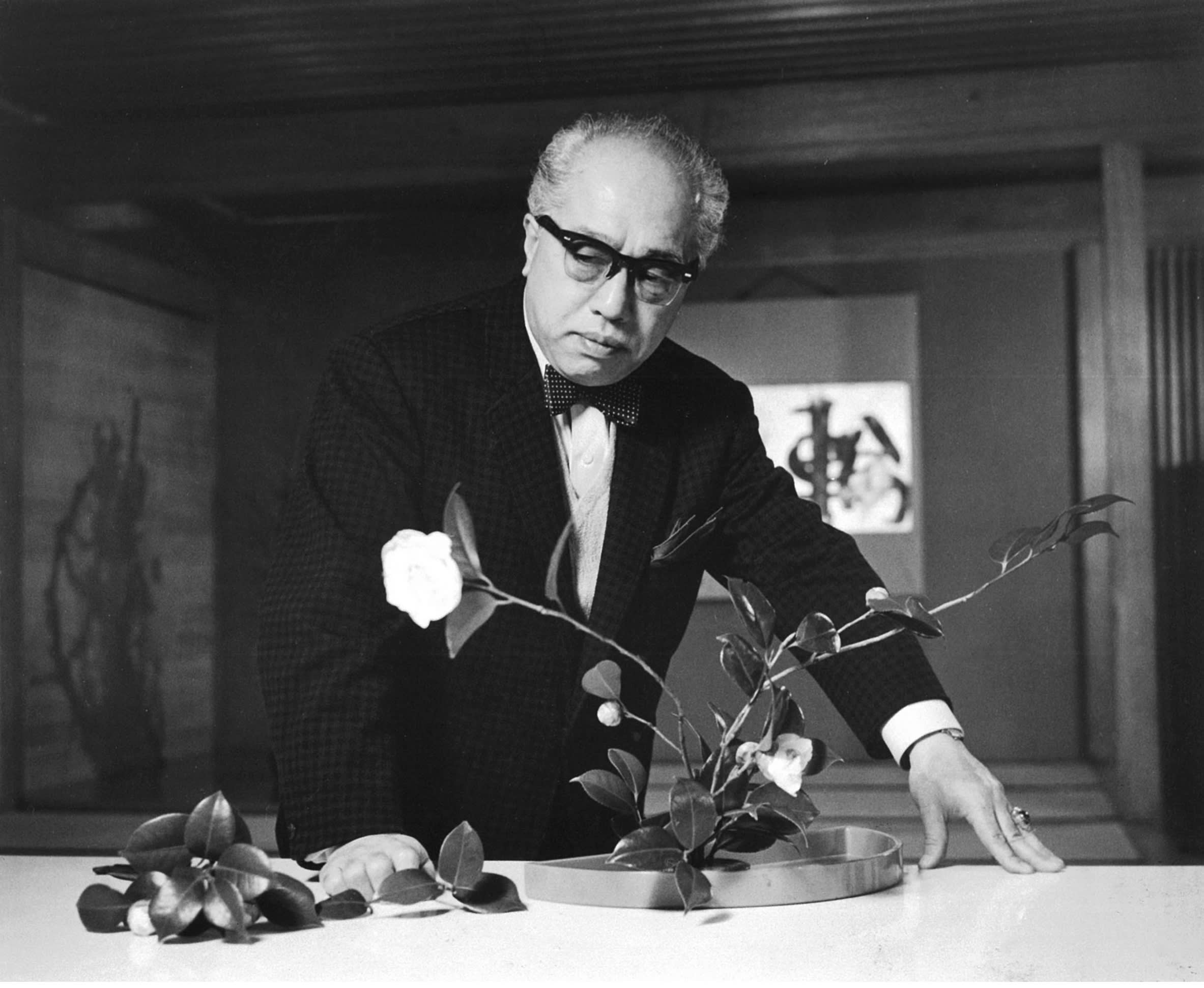
Teshigahara’s innovative merging of ikebana and sculpture is evident in many of his pieces: Several feature openings or cuplike recesses that seem poised to receive flowers. Kikansha (1951), which translates as ‘locomotive’, flaunts an array of wheels and a tubular smokestack, as well as wittily designed, pot-like components; the work is both an arrangement and a vessel. Rooted in an ancient tradition which is still alive today, almost all of the late master’s work suggests the potential presence of floral components which would serve to complete them.
Ayako Someya (b. 1981) is an artist who sees herself as a descendant of Postwar Japanese calligraphic artists like Yuiichi Inoue (1916–1985), who had reestablished calligraphy as a progressive fine-art form after it had been officially downgraded in the late 19th century. Japanese calligraphy is conventionally based on writing, expected to convey the linguistic significance of the kanji or kana characters used. Someya’s work overturns this, finding an equally apt body of inspiration in the structure of matter itself. ‘Like kanji,’ the artist explained at a recent exhibition opening in Tokyo, ‘the forms and patterns of molecular diagrams are essentially fixed. Each provides a basic structure that can be interpreted like a single character.’

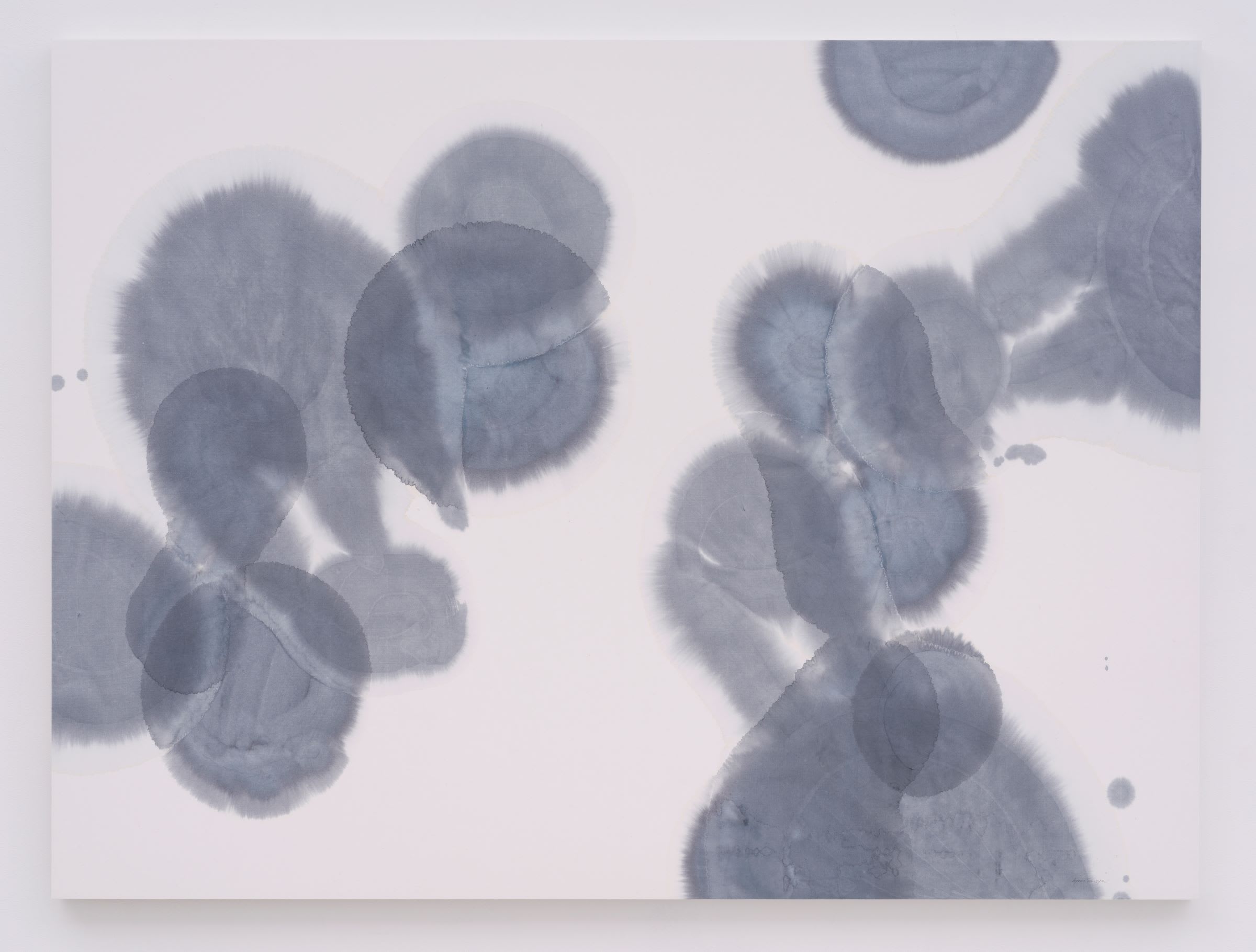
Someya’s practice is nevertheless highly traditional and refined. She creates her sumi ink on washi paper works in a range of scales, from the intimate to monumental, multi-panel pieces. Preferring a type of Chinese washi that is particularly absorbent, she often uses seiboku ink, with its slight blue tinge becoming more apparent as it bleeds delicately into the paper.
Paintings in Someya’s solo exhibition at Tokyo Gallery + BTAP in the Japanese capital early last year were based on elements and compounds found in the air: O2 (2022), N2 (versions from 2022 and 2023), and CO2 (2023). After considerable time spent in preparatory thought, each painting takes just a few seconds to create, using long, unrehearsed, continuous strokes. ‘My mind is empty when I actually paint,’ Someya explained. The artist’s stated intent in this body of work is to call attention to the changing environment, but in fact, these works are akin to breath embodied.
Ceramics play a fundamental role in Japanese culture. Under the creative guidance of 16th-century tea masters like Sen no Rikyū, humble and rough-hewn pottery vessels were prized as highly refined cultural artifacts. The dynamically scarred and ruptured creations of the contemporary ceramic artist Yuji Ueda (b. 1975) question the conventions of this ancient medium in notable ways. Ueda works in the famous pottery village of Shiga, north of Kyoto, where the first kilns were created in the 12th century. ‘I consider myself a ceramic artist (tougeika),’ he said in a recent video call with Art Basel, ‘as opposed to a sculptor. And I don’t think my work represents anything really new. Tradition and continuity with the past are important to me.’
Although some of Ueda’s pieces function as vessels, most appear to be exuberant failures, cracked and unusable, like ambitious experiments gone awry. Others suggest wildly deformed archaeological finds. Using an unusual technique that involves layering different local clays and powdered glazes in plaster molds, Ueda creates large works derived from archaic pottery vessel forms which are then fired in a traditional wood-fired anagama kiln that he built himself. The clays are carefully chosen for how they react to both each other and with the feldspar, copper, and other materials he introduces. Ueda states that it’s very important that the work’s final form is not totally under his control, and that he aims to convey both beauty and horror. As glassy colors burst forth, renewed, through the chaotic and charred surfaces, we sense the progress of time and the beauty of passing eons.
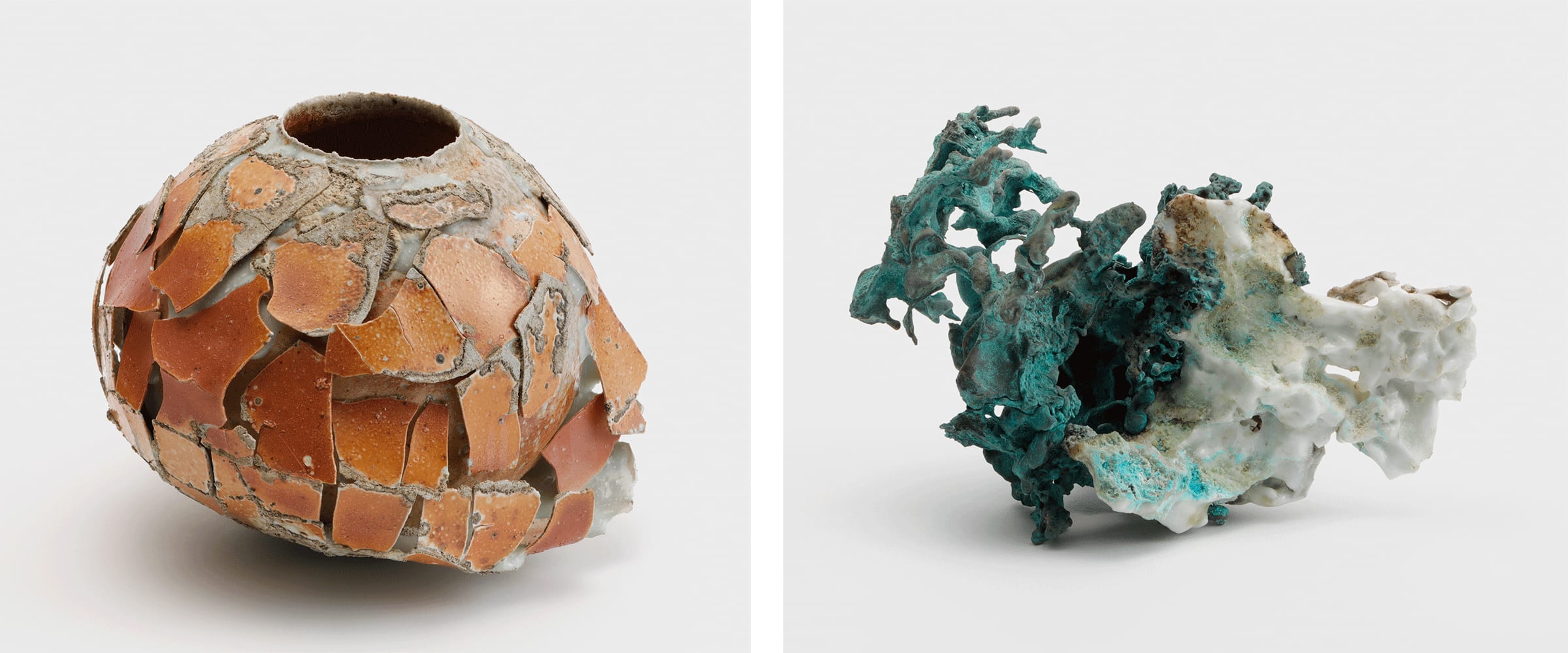
Kyoto-based Genta Ishizuka (b. 1982) works innovatively with an ancient Japanese urushi lacquer technique called kanshitsu, or ‘dry lacquer’. Introduced to Japan from China in the seventh century, it was soon supplanted by less time-consuming techniques. Instead of using solid wood substrate as in most urushi works, traditional kanshitsu objects are made by sculpturally forming layers of urushi-impregnated linen fabric around a clay or wooden core which is later removed, resulting in a hollow, lightweight, but strong finished object once cured. (Urushi doesn’t actually dry, but rather it is an ancient biotechnology that hardens through polymerization with the help of moisture in the air and enzymes.)
Very few people now master this technique, but Ishizuka employs it to create striking, large scale abstract works as well as smaller objects. Pieces in his ‘Surface Tactility’ series, begun in 2015, resemble lustrous blobs which recall clusters of cells, astronomical phenomena, or emergent life forms. Their black, burgundy, brown, or gold coloration evokes the material’s highly prized response to dim light – a cornerstone of Japanese traditional aesthetics, in which evocative shadow is considered more pleasurable than brightness.

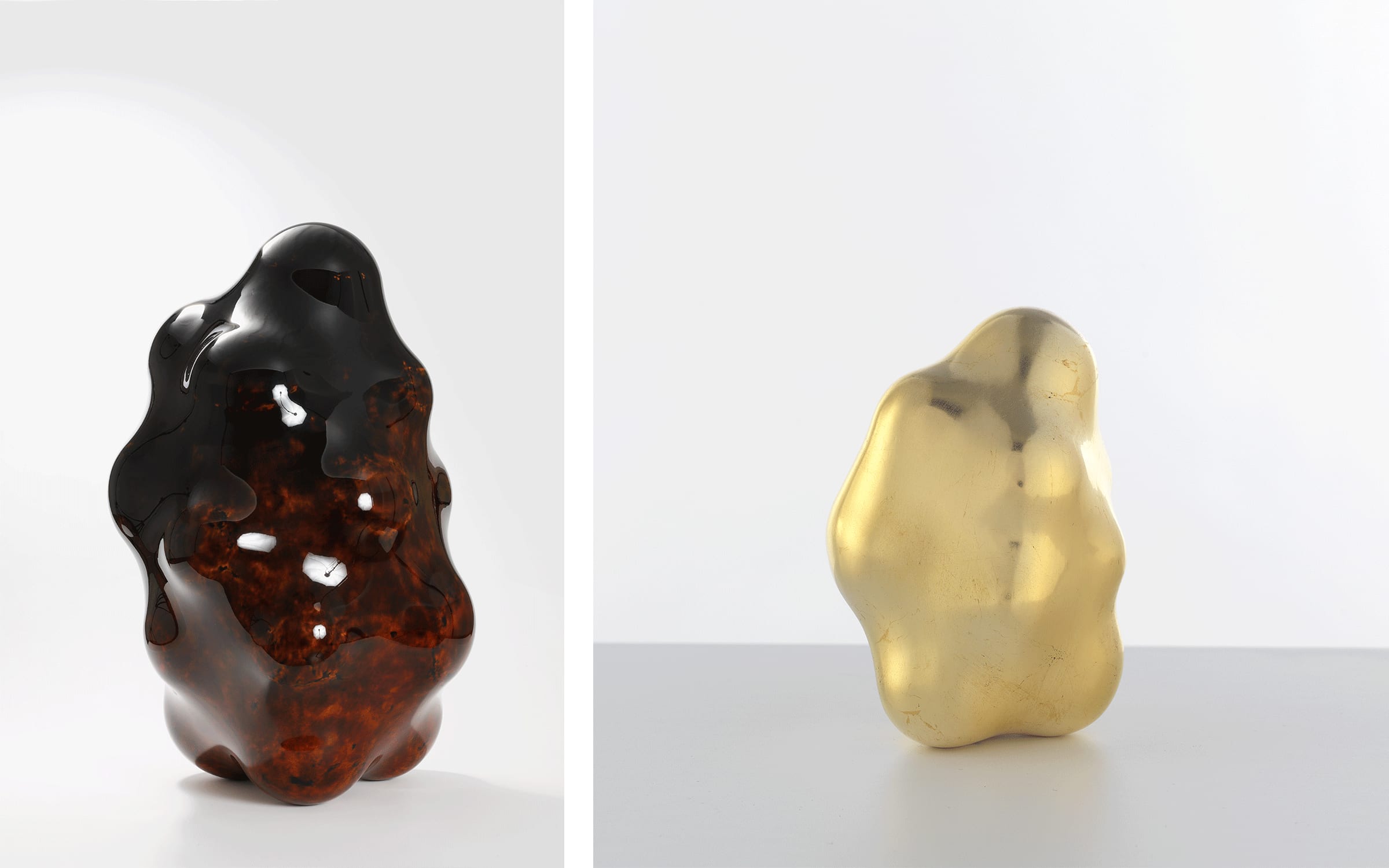
Ishizuka uses two-way tricot fabric stretched over wire forms or styrofoam as substrate for the urushi-impregnated linen, allowing him to compose his tensile forms with tremendous freedom and control. Over 30 layers are normally required; each must be allowed to set and be carefully polished before the next is added. Because of this, large works require about three months to create, and only three or four can be produced each year. ‘The feeling of tension is most important in these pieces,’ Ishizuka explained on a phone call. ‘They were initially inspired by a mesh bag bulging with mikan tangerines.’
The materials used by these artists are as important as the techniques they employ to create their works – something characteristic of traditional Japanese art forms, where every aspect, from the texture of a specific clay to the resilience of a silk thread, matters. Kazuo Kadonaga (b. 1946) has taken this appreciation for the very substance of his works a step further.
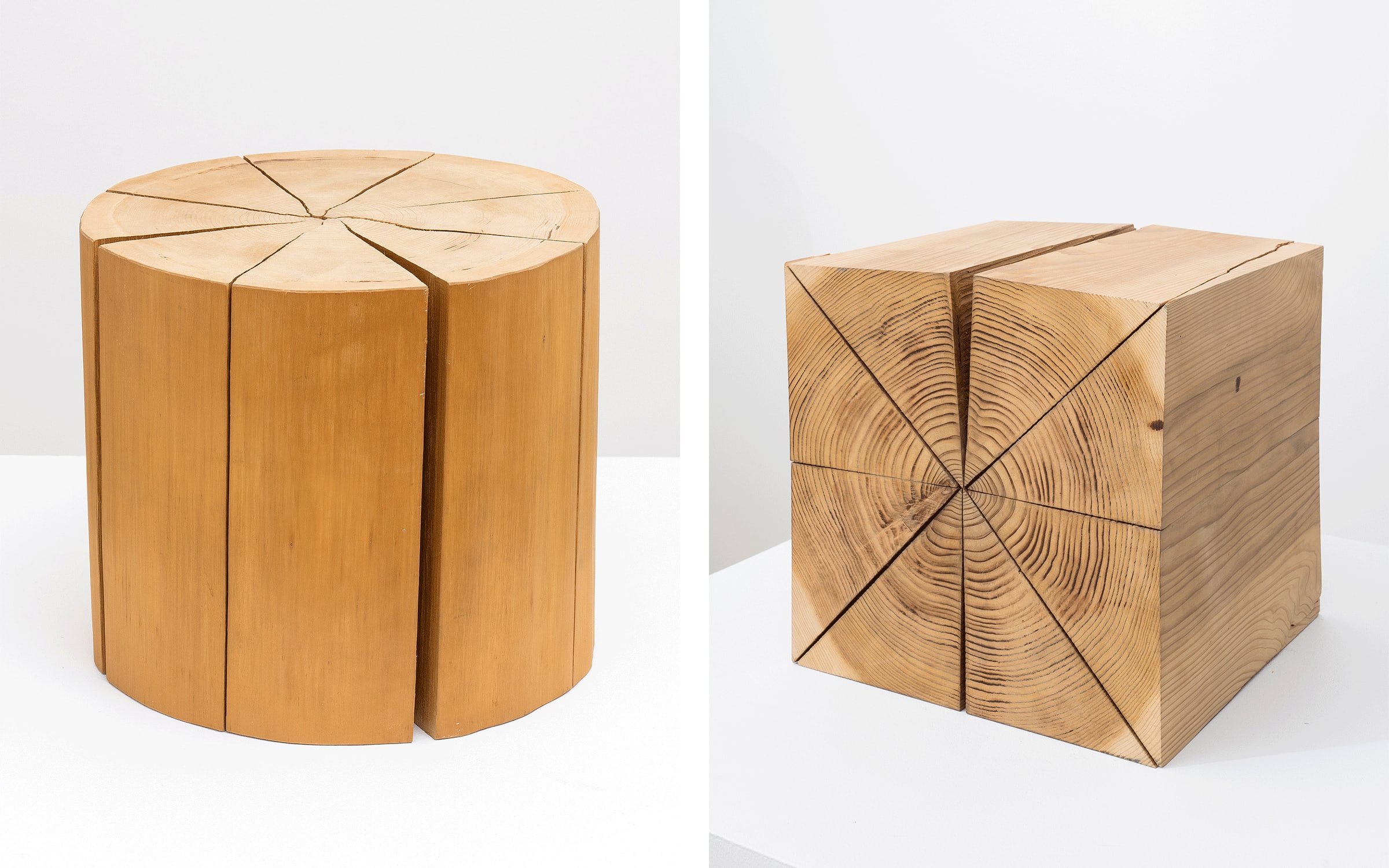
Kadonaga comes from a family of prominent lumber dealers in Tsurugi, Ishikawa. Growing up, he was intimately aware of the forests and how living trees can be transformed into other forms. ‘Being constantly surrounded by these trees,’ he said during an interview with Art Basel at his studio, ‘it made sense for me to use them in my work.’ The artist’s wood sculptures involve slicing a log that has been stripped of its bark into hundreds of layers of 0.5mm veneer, and reassembling them to reconstitute the entire log. Thus transformed, they remain undeniably pristine – no longer intact, but, paradoxically, preserving the logs’ original form.
Kadonaga’s deep interest in materials isn’t limited to lumber. The 10 x 15-meter Silk No.4A (2011) is part of a large, ongoing body of work that employs thousands of living silkworms spinning silk onto wooden frameworks in a controlled fashion. The artist also creates equally complex, massive glass sculptures by using a system of his own design that includes automated feed hoppers, melting crucibles, drip systems, and cooling kilns. Artworks made with traditional materials often highlight consummate hand skills which Japanese practitioners typically spend decades perfecting, but Kadonaga prefers to let nature and technology do the work. His pieces could possibly be produced anywhere, but in fact his systemic, process-based approach remains rooted in the local environment, and on traditionally available materials.
Sōfū Teshigahara is represented by Taka Ishii Gallery (Tokyo, Kyoto).
Ayako Someya is represented by Tokyo Gallery + BTAP (Tokyo, Beijing).
Yuji Ueda is represented by Blum (Los Angeles, New York, Tokyo) and Kaikai Kiki (Tokyo).
Kazuo Kadonaga is represented by Nonaka-Hill (Los Angeles).
Genta Ishizuka is represented by Artcourt Gallery (Osaka, Kyoto) and Erskine, Hall & Coe (London).
Azby Brown is a Japanese art, architecture, and design specialist, and has lived in Japan since 1985.
Caption for full-bleed images, from top to bottom: 1. Genta Ishizuka, Surface Tactility #29 (Detail), 2023. Photograph by Takeru Koroda. Courtesy of Kyoto City KYOCERA Museum of Art. 2. Yuji Ueda, Untitled (detail), 2023. Photograph by Takeru Koroda © Yuji Ueda; Courtesy of the artist and BLUM Los Angeles, Tokyo, New York. 3. Kazuo Kadonaga, Glass No. 8 B (detail), 2015. Courtesy of the artist and Nonaka-Hill, Los Angeles.
Published on January 15, 2024.